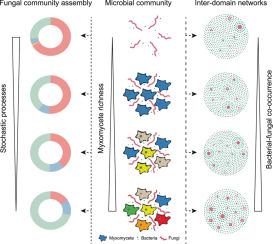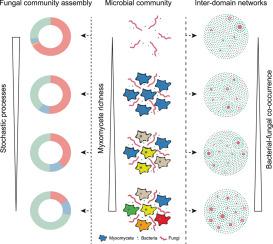土壤变形虫丰富度驱动局部规模的细菌和真菌群落聚集
IF 10.3
1区 农林科学
Q1 SOIL SCIENCE
引用次数: 0
摘要
原生生物是土壤微生物食物网中细菌和真菌的主要消费者。然而,原生生物多样性在塑造细菌和真菌群落组装中的作用仍不清楚。为了解决这一差距,我们通过实地观察和微观实验研究了不同水平的黏菌(变形虫原生生物)多样性如何影响细菌和真菌群落的组装。结果表明,黏菌物种丰富度显著影响真菌群落的组装过程,而不是细菌群落的组装过程。黏菌丰富度的增加通过增强同质选择促进确定性真菌组装。此外,黏菌丰富度影响域间网络中细菌-真菌的共存,间接推动细菌群落的更替。这些发现强调了变形虫原生生物对真菌施加的直接自上而下的控制以及形成细菌群落的间接营养相互作用。他们强调了原生生物多样性作为土壤微生物群落聚集的关键驱动力的作用,并为微生物食物网的复杂性提供了新的见解。本文章由计算机程序翻译,如有差异,请以英文原文为准。


Soil amoeba richness drives local-scale bacterial and fungal community assembly
Protists are the primary consumers of bacteria and fungi within the soil microbial food web. However, the role of protist diversity in shaping bacterial and fungal community assembly remains unclear. To address this gap, we investigated how different levels of myxomycete (amoeboid protist) diversity affect the assembly of bacterial and fungal communities through field observations and microcosm experiments. Results indicate that myxomycete species richness significantly influences the assembly processes of fungal communities at the local scale, rather than those of bacterial communities. Increased myxomycete richness promotes deterministic fungal assembly by enhancing homogeneous selection. Additionally, myxomycete richness influences bacterial-fungal co-occurrence in inter-domain networks, indirectly driving bacterial community turnover. These findings highlight the direct top-down control exerted by amoeboid protists on fungi and the indirect trophic interactions that shape bacterial communities. They underscore the role of protist diversity as a key driver of soil microbial community assembly and provide novel insights into the complexity of microbial food webs.
求助全文
通过发布文献求助,成功后即可免费获取论文全文。
去求助
来源期刊

Soil Biology & Biochemistry
农林科学-土壤科学
CiteScore
16.90
自引率
9.30%
发文量
312
审稿时长
49 days
期刊介绍:
Soil Biology & Biochemistry publishes original research articles of international significance focusing on biological processes in soil and their applications to soil and environmental quality. Major topics include the ecology and biochemical processes of soil organisms, their effects on the environment, and interactions with plants. The journal also welcomes state-of-the-art reviews and discussions on contemporary research in soil biology and biochemistry.
 求助内容:
求助内容: 应助结果提醒方式:
应助结果提醒方式:


